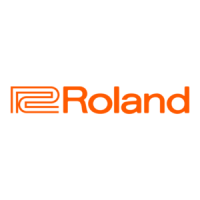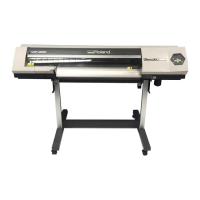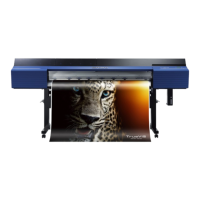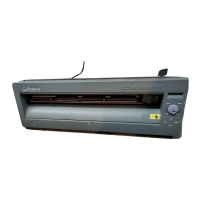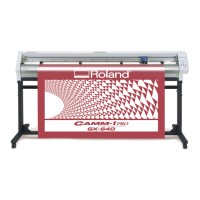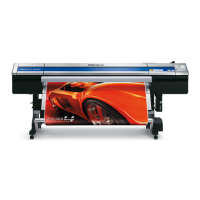
Do you have a question about the Roland SOLJET Pro 4 XR-640 and is the answer not in the manual?
| Ink Type | ECO-SOL MAX 2 |
|---|---|
| Print Technology | Piezo inkjet |
| Maximum Print Width | 63.6 in (1615 mm) |
| Resolution | Up to 1440 dpi |
| Media Width | 64 inches |
| Cutting Speed | Up to 300 mm/s (11.8 in/s) |
| Connectivity | Ethernet (10BASE-T/100BASE-TX) |
| Ink Configuration | CMYK, Light Cyan, Light Magenta, White, Metallic |
| Print Speed | Up to 528 sqft/hr (49 m²/h) |
| Media Thickness | Maximum 1.0 mm with liner |
| Power Requirements | AC 220 to 240 V ±10 %, 50/60 Hz |
| Operating Environment | Temperature: 68 to 90 °F (20 to 32 °C), Humidity: 35 to 80 %RH (no condensation) |
Explains the meaning of WARNING and CAUTION labels used in the manual.
Explains the meaning of various safety symbols used to indicate hazards.
Details safety measures to prevent injury from incorrect operation or handling of the machine.
Outlines precautions against electrical hazards, fire, and exposure to water/humidity.
Provides critical guidelines for safe handling and use of power cords, plugs, and outlets.
Details safety precautions for flammable and toxic inks, cleaning fluids, and discharged fluids.
Addresses the machine's weight and safe handling procedures, including caster locking.
Warns about high temperatures and potential release of toxic gases from media.
Explains the meaning and placement of various warning labels on the machine.
Details the requirements for the machine's installation location.
Specifies the optimal temperature and humidity ranges for machine operation and non-operation.
Shows the necessary dimensions for unit and work space around the machine.
Lists all the components that are packed with the machine.
Details the remaining included items, such as tools, manuals, and consumables.
Guides through the physical assembly and installation of the machine.
Provides detailed instructions for assembling the machine's stand.
Instructions for attaching the rail slider and arm to the assembled stand legs.
Details the process of attaching the dancer roller to the stand legs.
Guides on how to attach the paper tube, including setting end caps.
Instructions for carefully placing and securing the main machine unit onto the stand.
Steps for installing the media holder onto the shafts.
Instructions for setting up the drain bottle and its stand.
Guides on how to attach the ink-cartridge tray to the machine.
Instructions for removing protective packing materials from the machine.
Instructions for connecting various cables to the machine.
Guides on connecting the power cord and Ethernet cable, with safety warnings.
Instructions for installing ink cartridges, including initial filling procedures.
Explains the initial ink filling process, requiring specific cartridges.
Guides through powering on the machine and configuring initial settings like language.
Instructions for selecting the appropriate ink type based on machine configuration.
Details the process of cleaning using a cleaning stick and fluid.
Guides on cleaning print heads using SOL INK cleaning cartridges.
Instructions for inserting the correct ink cartridges into their designated color slots.
Describes the procedure for cleaning the print heads using the machine's interface.
Provides instructions for installing a new blade into the blade holder.
Details the steps for inserting the blade and its pin into the blade holder.
Guides on how to properly install the blade holder onto the cutting carriage.
Introduces network configuration for connecting the machine to a network.
Details how to configure network settings on a Windows computer.
Guides on setting the IP address on the printer via its operation panel.
Covers configuring the subnet mask and gateway address on the printer.
Explains how to set up port settings for the software RIP.
Provides guidance on maintenance and care when the machine is not in use.
Details monthly maintenance by switching on the power to prevent print head drying.
Emphasizes keeping the machine within specified temperature and humidity ranges during non-use.
Explains the alarm that sounds when the machine is unused for about a month.
Outlines procedures for preparing and moving the machine.
Lists items needed and important notes for safely moving the machine.
Details the process of draining ink and cleaning the machine's interior before moving.
Explains how to secure print heads and other parts for moving.
Advises on moving the machine and refilling ink promptly after transport.



